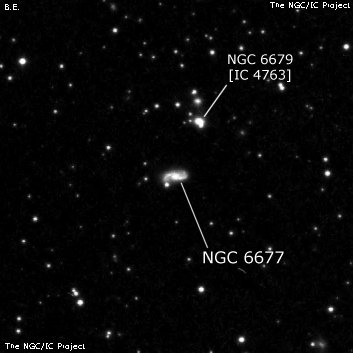
Guillaume Bigourdan found IC 4763 (= NGC 6679) on 5 Sep 1891 and recorded "this object is perhaps the double indicated by Swift near NGC 6677. It seems accompanied by a little nebulosity and I can not split it." IC 4763 is often misidentified as the compact galaxy MCG +11-22-056 = PGC 62026, just 36" N of NGC 6679. See NGC 6679 for more.
400/500mm - 17.5" (6/11/88): fairly faint, very small, elongated SW-NE. One or two extremely faint stars are possibly involved or close off the edge. Forms a close pair with NGC 6677 1.7' SSE. MCG +11-22-056, a nearly stellar galaxy just 38" N was not seen.
600/800mm - 24" (8/27/14): fairly faint to moderately bright, small, round, 18" diameter, fairly high surface brightness. A mag 14.5 star is attached at the southwest edge.
MCG +11-22-056 = PGC 62026 lies just 0.6' N. At 375x it appeared extremely faint or very faint, round, just 8"-10" diameter. Once in my averted vision sweet spot, I could nearly hold this galaxy continuously. A mag 15 star (brighter than the galaxy) lies 0.3' NNE.
900/1200mm - 48" (10/22/11): bright, fairly small, round, high surface brightness, 20" diameter. A 14th magnitude star is attached at the southwest edge and a mag 16.5 star is 20" NE. In a close trio with NGC 6677 1.7' SSE and MCG +11-22-056 = PGC 62026 is 0.6' N. The MCG companion (identified as IC 4763 in MCG and as NGC 6679 in PGC and Megastar) appeared fairly faint, small, slightly elongated, 0.3'x0.2'. A 15th magnitude star is 18" NNE.
Zwicky described the pair (VII Zw 814) with MCG +11-22-056 as "post-eruptive blue patchy compacts interconnected by a broad uniform bridge, separation = 30" NNE-SSW."
Notes by Steve Gottlieb